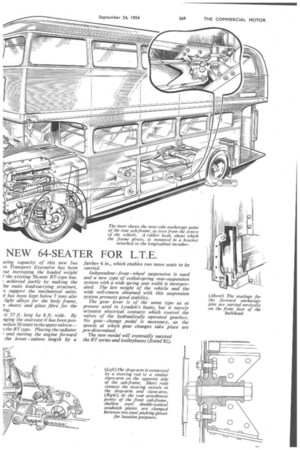NEW 64-SEATER FOR L.T.E.
Page 153

If you've noticed an error in this article please click here to report it so we can fix it.
ating capacity of this new bus m Transport Executive has been out increasing the loaded weight fthe existing 56-seat RT-type bus. ! achieved partly by making the he main load-carrying structure, support the mechanical units. It has been kept below 7 tons also light alloys for the body frame, I sheets and glass fibre for the ing.
is 27 ft. long by 8 ft. wide. By ng-ing the staircase it has been posiodate36seats in the upper saloon— the RT type. Placing the radiator and moving the engine forward the lower saloon length by a further 6 in., which enables two more seats to be carried.
Independent -front wheel suspension is used and a new type of coiled-spring rear-suspension system with a wide spring seat width is incorporated. The low weight of the vehicle and the wide roll-centre obtained with this suspension system promote good stability.
The gear lever is of the same type as at present used in London's buses, but it merely actuates electrical contacts which control the valves of the hydraulically operated gearbox. No gear change pedal is necessary, as the speeds at which gear changes take place are pre-determined.
The new model will eventually succeed the RT series and trolleybuses (Stand 81).
























































































































































































































































































































